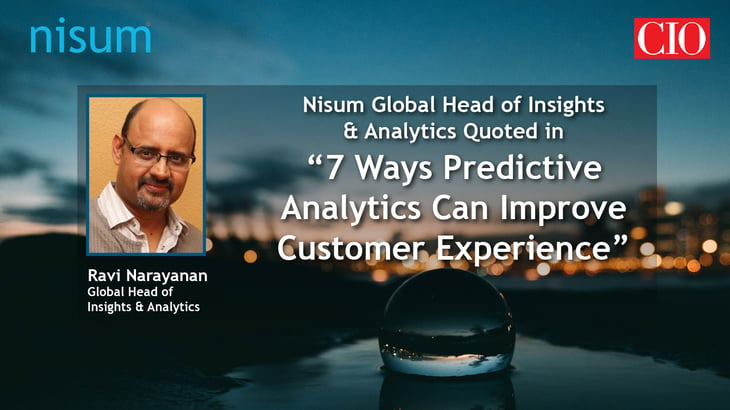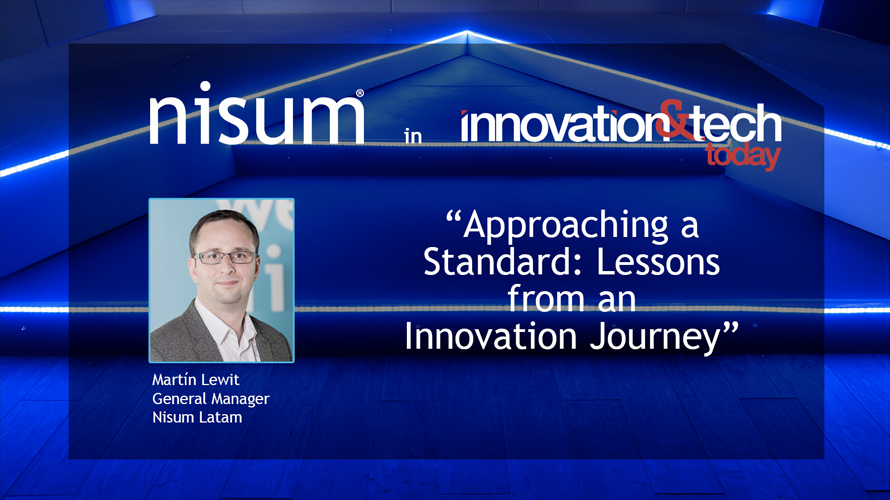CIO.com's veteran business technology journalist, John Edwards features Nisum’s Global Head of Insights & Analytics, Ravi Narayanan in "7 ways predictive analytics can improve customer experience." Ravi shares how predictive analytics can provide great insight on customers’ needs and expectations.
Read the full text below or view the article here.
7 Ways Predictive Analytics Can Improve Customer Experience
AI-powered analytics can drive sales to higher levels by helping organizations anticipate customers' needs and exceed their expectations.
It’s a win-win situation. Predictive analytics is revolutionizing the customer-marketer relationship, boosting sales while simultaneously increasing shopper satisfaction.
And it’s all because of data, business’ new superpower, states Paul Gaynor, a partner at professional services firm PwC. “Advanced business analytics gives you the ability to see and predict everything, everywhere,” he explains. “Every interaction with customers, every moving part in your supply chain, every financial transaction, anywhere in the world.”
In the increasingly cutthroat retail world, predictive analytics gives sellers a powerful new edge, one that more than compensates for the internet’s ever-expanding array of choices and anytime, anywhere comparative shopping.
“Predictive analytics help you know what might happen, prepare a response ahead of time, get ahead of the risks, and influence the outcomes,” Gaynor says. “It’s like looking ahead with a telescope, not glancing through the rear-view mirror.”
Still skeptical that predictive analytics is the most powerful marketing tool since the arrival of online shopping? Then consider these seven ways your organization can use the technology to take customer service — and sales — to the next level.
1. Hyper personalized marketing
Hyper personalized marketing is all about serving customers the right message at the right time on the right channel. Mastering it requires a merging of art and science. The science part, observes Bindu Thota, vice president of technology for online clothing and accessories retailer Zulily, is giving shoppers the right mix of categories, selections, price points, shipping times, and other key services. “The art comes into play when we determine how we curate these elements, how we weave them together to create the most engaging customer experience,” she notes.
Imagine a world in which the retailer knows exactly what a shopper wants even before arriving on the company’s website or app. That’s a capability predictive analytics can provide. “Through data-driven technology, we can create a personalized collection, incorporating thousands of products, every single day — a customer experience that is truly relevant and engaging,” Thota says. “That is the human touch.”
For the first time in history, social media and other online avenues allow marketers to interact with people anytime, anywhere. “This provides an unparalleled opportunity to discover the emerging patterns that help companies marshal their resources and direct their energies more effectively,” explains Adam Lichtl, founder of Pacific Data Science, a data analytics consulting firm. “By collecting all these little points of data around the customer experience and integrating them together we can get a better picture of the customer journey — before, during, and after they engage with the company.”
2. Virtual concierges
Consumers have come to expect instant, frictionless gratification in all aspects of their lives and now expect similar experiences with the brands they interact with. “Predictive analytics is a critical tool in delivering a comprehensive view of the consumer to provide these types of experiences,” says Ravi Narayanan, global head of insights and analytics at Nisum, a business and technology consulting firm.
Using AI-driven analytics, it’s now possible to create both an immersive experience and instant gratification. “Spotify and Netflix, for instance, change their suggestions based on what you are watching or listening to at the moment,” Narayanan says.
3. Customer needs forecasting
Organizations can now use predictive analytics to precisely forecast customers’ needs, in some cases even before the individual has made up his or her mind. “Predictive analytics can provide early detection of precursors to change in customer behavior,” Lichtl observed. This allows brands to be more proactive, enabling them to tailor their messages in anticipation, effectively serving the customer before they even know they have a new need. It’s an approach that allows organizations to provide superior customer service, Lichtl noted.
Lance Gruner, Mastercard’s executive vice president of customer experience and care, notes that predictive analytics helps his company ensure it has the right amount of support in place to address customers’ needs in a timely fashion and then exceed their expectations. “In addition to forecasting the volume of inquiries so that we can resource accordingly, we’re also using advanced models to predict the complexity of the inquiry,” Gruner says.
Looking to get inside its customers’ heads, AT&T Business has implemented a customer experience machine learning system. The technology ingests hundreds of unique data elements — literally petabytes worth of data — throughout customer project lifecycles. “It predicts, based upon customer effort, cycle time, retry rates and so on, if a customer will stay a promoter or if they start sliding towards neutral or detractor territory,” explains Sorabh Saxena, AT&T Business’ president of global operations and services. The system generates predictive alarms that drive the next-best-action recommendation, either automatically or via system assist, to ensure that the customer remains a promoter. “The best part is that it is constantly learning and fine-tuning the algorithms as it gets more experience,” he says.
4. Customer churn reduction
Retailers have long searched for ways of reducing customer churn, the percentage of once-loyal buyers who have stopped acquiring a company’s products or services during a specific time frame. Also known as customer attrition, customer churn is a critical metric, given that it’s far less expensive to retain existing customers than it is to acquire new ones.
“Predictive analytics can be used to identify customers presenting a high churn risk and help businesses take proactive attention to enhance customer experience and serve their needs better,” notes Seongjoon Koo, chief data officer at marketing information services provider J.D. Power. Disaffected customers can often be lured back into the fold with incentives, such as time payment plans or lower price alternatives.
Analytics-delivered clues, such as a denied loan request, can alert a bank or other financial institution to customers presenting a high churn risk. “Upon learning this intel, the bank could then act pre-emptively to prevent customer churn by offering additional options, like a credit card with a generous limit,” explains Moritz Zimmermann, SAP Customer Experience’s CTO.
5. Resources management
Predictive analytics can also help organizations allocate their resources more intelligently and productively. “We’ve helped retailers combine insight from their store footprints, logistics, and customer behavior to accurately plan staffing levels, weeks in advance,” Gaynor says. “This will enable customers to have a smooth, better, and faster experience with that retailer.”
Using predictive models, sellers can create accurate inventory forecasts and manage resources to match customer behaviors and needs, observes Dennis Amorosano, senior vice president and general manager at Canon Information and Imaging Solutions. The benefits are two-fold, he notes. “Companies can be more efficient, streamlining costs and reducing wasted resources, and customers receive the timely and personalized experiences that they have come to expect.”
Canon uses a combination of remote monitoring and predictive analytics to forecast its imaging equipment service needs and provide timely supply shipments to customers. The company also relies on predictive maintenance models to perform real-time diagnostics on customer equipment delivered to its headquarters-based customer solutions center, Amorosano says.
6. Internal team support
Predictive analytics gives internal support teams the insights needed to resolve customer problems quickly and accurately. “It’s a key tool in our arsenal to better understand and improve the customer experience,” Gruner says.
By drawing on predictive analytics fed by phone calls, emails, social media sentiment, customer escalations, and other key channels, Mastercard representatives can determine the best way to address specific types of customer demands. “Taking all of these inputs into account helps us to be more prepared to address customer needs and make better business decisions,” Gruner notes. “Predictive analytics helps to ensure we have the right amount of support in place to address customers’ needs in a timely fashion and exceed their expectations.”
7. Streamlined shipping
Predictive analytics enables organizations to enhance the customer experience all the way up to delivery day. With more customers demanding next-day and same-day deliveries, predictive analytics helps retailers and their shipping partners ensure reliable, on-time arrivals.
By forecasting potential maintenance issues and pinpointing optimal transport routes, predictive analytics now plays a major role in ensuring that delivery schedules are met on time. “[Analytics] allows for each driver to have better expectations about their journey … and departments of transportation can communicate earlier what adjustments need to be made on transport routes to manage volume, thereby impacting experience,” Gaynor says.




